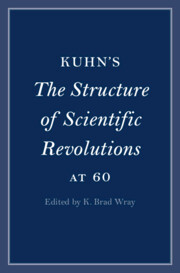Book contents
- Kuhn’s The Structure of Scientific Revolutions at 60
- Cambridge Philosophical Anniversaries
- Kuhn’s The Structure of Scientific Revolutions at 60
- Copyright page
- Dedication
- Contents
- Figures
- Tables
- Contributors
- Acknowledgments
- Abbreviations
- Introduction
- Part I Writing Structure
- Part II Normal Science and Science Education
- 3 Kuhn’s “Fifth Law of Thermodynamics”
- 4 Normal Science
- 5 “Textbook Science” before and after Structure
- 6 Thomas Kuhn, Normal Science, and Education
- Part III Incommensurability, Progress, and Revolutions
- Part IV Kuhn’s Impact on the Philosophy, Sociology, and History of Science
- Bibliography
- Index
5 - “Textbook Science” before and after Structure
from Part II - Normal Science and Science Education
Published online by Cambridge University Press: 05 January 2024
- Kuhn’s The Structure of Scientific Revolutions at 60
- Cambridge Philosophical Anniversaries
- Kuhn’s The Structure of Scientific Revolutions at 60
- Copyright page
- Dedication
- Contents
- Figures
- Tables
- Contributors
- Acknowledgments
- Abbreviations
- Introduction
- Part I Writing Structure
- Part II Normal Science and Science Education
- 3 Kuhn’s “Fifth Law of Thermodynamics”
- 4 Normal Science
- 5 “Textbook Science” before and after Structure
- 6 Thomas Kuhn, Normal Science, and Education
- Part III Incommensurability, Progress, and Revolutions
- Part IV Kuhn’s Impact on the Philosophy, Sociology, and History of Science
- Bibliography
- Index
Summary
For Kuhn, textbook science is both a misleading rational reconstruction and an actual driver of normal science. Ludwik Fleck’s account of how textbooks stabilize scientific collectives illuminates the latter. Auguste Comte’s distinction between the theoretical method of instruction, which presents science ahistorically as a system of rational conclusions, and the historical method of instruction, which presents science as a series of effects, illuminate the former. Current STEM textbooks still employ the theoretical method, which obscures the role of historical accident when theory choice is underdetermined by rules. Kuhn and his mentor James B. Conant, in contrast, promote a case study approach. In our new learner-centered educational paradigm, we will need a new textbook science, one that leaves actual books behind.
Keywords
- Type
- Chapter
- Information
- Kuhn's The Structure of Scientific Revolutions at 60 , pp. 95 - 120Publisher: Cambridge University PressPrint publication year: 2024

